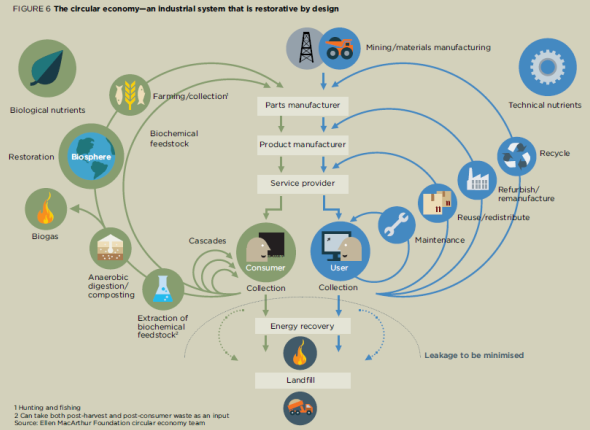 Our current linear production and consumption model of “take, make and dispose” is not sustainable. We no longer can afford to use more limited resources and create more waste. We have to change, and the alternative model that is fast gaining traction is the circular economy.
Our current linear production and consumption model of “take, make and dispose” is not sustainable. We no longer can afford to use more limited resources and create more waste. We have to change, and the alternative model that is fast gaining traction is the circular economy.
Driven by the Ellen MacArthur Foundation and building upon concepts such as Cradle to Cradle, Industrial Ecology and Biomimicry, the circular economy is likely to be the next big sustainability trend.
What is the Circular Economy?
According to the World Economic Forum: “a circular economy is an industrial system that is restorative or regenerative by intention and design. It replaces the end-of-life concept with restoration, shifts towards the use of renewable energy, eliminates the use of toxic chemicals, which impair reuse and return to the biosphere, and aims for the elimination of waste through the superior design of materials, products, systems and business models.”
The circular economy involves two types of materials flows, described by William McDonough and Michael Braungart in their book, Cradle to Cradle: biological nutrients that are non-toxic and can be returned back to the environment safely, and technical nutrients that are circulated within the economy with minimal loss of quality.
The emphasis is on designing out waste, adopting systems thinking, and creating services and access instead of product ownership. This diagram from the Ellen MacArthur Foundation’s report, Towards the Circular Economy vol. 1, shows the material cycles in the circular economy:
The benefits of the circular economy includes:
- Reduction in resource scarcity, supply risks, price volatility, waste disposal and environmental pollution
- Increase in material and resource savings, reuse and recycling, new jobs and business models, and consumer choices and loyalty
Status of the Circular Economy in Singapore
In Singapore, there are no clear regulations on mandatory recycling, Extended Producer Responsibility policies, nor mandatory take back programmes for used products and materials. There is no clear focus on the circular economy, and most business models are based on selling more products to consumers. The term “zero waste” is sometimes used by the government, but usually refers to recycling rather than on redesign, reduce and reuse.
There are no government agencies looking at sustainable design of products, only on aesthetics and functional design. There is no emphasis on the redesign of products to reduce or eliminate waste (though the Sustainable Manufacturing Centre looks at green manufacturing).
For technical nutrients, consumers usually dispose items that end up in the waste-to-energy plants. Consumers would usually buy new items instead of repairing spoilt items. Used items are commonly given away (e.g. through Singapore Freecycle, Salvation Army and other non-profits) or sold for reuse locally or exported (e.g. through Cash Converters, karang gunis and secondhand dealers).
The sharing economy, which is a subset of the circular economy, is gaining traction in Singapore with several companies such as Rent Tycoons providing peer-to-peer rental of items, and Waste is not Waste providing business waste exchange.
The Sustainable Manufacturing Centre and the Advanced Remanufacturing and Technology Centre have been working with companies on remanufacturing in Singapore over the past few years.
The waste management and recycling industry is quite vibrant with over 100 companies involved in waste collection and sorting, waste treatment facilities, and recycling technologies and plants. Ferrous metals are usually recycled locally while non-ferrous metals are usually exported overseas for recycling. E-waste are recycled here where precious metals are extracted. Plastics are either recycled here or exported. Wood is recycled into compost or wood composite products, or reuse as wood chips for co-generation plants.
For biological nutrients, there are no anaerobic digestion plants to convert food waste into biogas. Some companies use an aerobic digester to convert food waste into compost or water, but most food waste ends up at the waste-to-energy plants.
Biodegradable items such as plastic bags, containers, utensils and cutlery made from plant-based materials, are usually sent to the waste-to-energy plants and are not sent for composting or allowed to biodegrade.
Opportunities for the Circular Economy in Singapore
Here are some key opportunities to build the circular economy in Singapore:
1) Set Policies on the Circular Economy
Currently there are no government policies addressing the potential of the circular economy. The government can set the direction and implement policies on the circular economy, which would help reduce incineration and landfilling of waste, build resilience on materials and resources, and create new job opportunities. Regulations such as Extended Producer Responsibility and minimum recycled content could be introduced.
2) Encourage Businesses to Explore the Circular Economy
Currently the awareness on the circular economy is lacking among companies. There should be more education and training for companies to increase awareness on the need, potential and skills for the circular economy.
Companies have to rethink their business models, adopt systems thinking, redesign their products and processes, and explore reuse, remanufacturing and recycling.
3) Educate Product Designers and Students on the Circular Economy
Tertiary institutions with courses on product design should be encouraged to include the concept of green design in their syllabus. Students should be exposed to circular economy concepts such as Cradle to Cradle, Biomimicry, and Design for Durability and Disassembly. In addition, students could have attachment and internship opportunities to work with product manufacturers to redesign their products for circularity.
There should also be more courses and workshops for product designers to learn about circular economy concepts and case studies.
4) Encourage Repair, Reuse, Redistribute and Sharing
Consumers should be educated that it is better to repair and reuse items instead of throwing them away. Unwanted items should be redistributed or sent for recycling.
Consumers can also look at the sharing economy to share, rent, borrow, give or exchange items, instead of buying them.
5) Increase the Use of Biological Nutrients
Food waste is currently incinerated as there are no anaerobic digestion plants in Singapore. Food waste are biological nutrients and should be collected and digested to produce biogas and fertilisers that can be safely returned back to the land.
Plastics are one of the most common types of waste generated in Singapore, and also commonly found as trash in our waterways and coasts. Plastic disposables and packaging are usually not collected for recycling due to contamination and low economic value. There could be opportunities to switch from plastic disposables and packaging to biodegradable ones, so that the material can be digested together with food waste in the digestion plants.
Image credit:Â Towards the Circular Economy vol. 1, Ellen MacArthur Foundation

